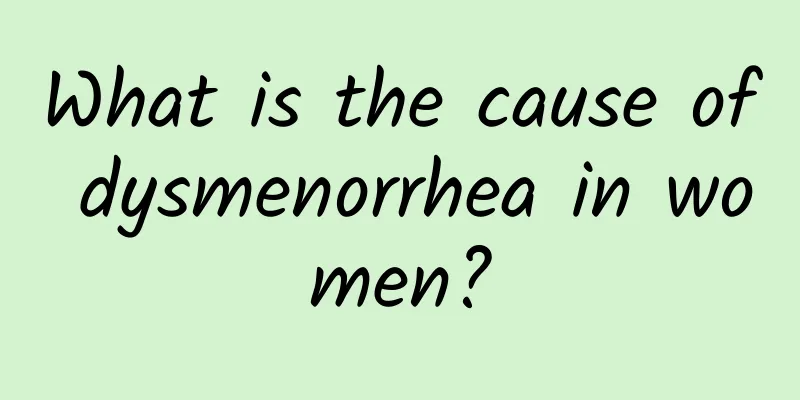What is the cause of dysmenorrhea in women?

|
Experts at the hospital pointed out that there are many causes of dysmenorrhea in women, with organic diseases being the most common, such as adenomyosis, excessive uterine curvature, intrauterine adhesions, pelvic adhesions, endometrial polyps, submucosal fibroids, cervical stenosis, uterine malformations, intrauterine contraceptive devices, hymen occlusion, etc., all of which can cause dysmenorrhea to varying degrees. The common causes of dysmenorrhea in women are as follows: (1) Cervical stenosis is mainly caused by obstruction of menstrual outflow, which causes dysmenorrhea. (2) Uterine hypoplasia Poor uterine development is prone to abnormal blood supply, causing uterine ischemia and hypoxia, leading to dysmenorrhea. (3) Abnormal uterine position: If a woman’s uterus is extremely retroflexed or anteflexed, it may affect the smooth flow of menstrual blood and cause dysmenorrhea. (4) Psychological and neurological factors: Some women are overly sensitive to pain. (5) Genetic factors: Dysmenorrhea in daughters is related to dysmenorrhea in mothers. (6) Endocrine factors: Abdominal pain during menstruation is related to increased progesterone in the luteal phase. (7) Dysmenorrhea caused by menarche, psychological stress, long periods of sitting leading to poor blood circulation, poor menstrual blood flow, and a preference for cold foods (8) The level of prostaglandins (PG) in the endometrium and menstrual blood increases. Prostaglandin E2 (PGE2) acts on uterine muscle fibers to cause them to contract and cause dysmenorrhea. The level of prostaglandins in the endometrial tissue of menstrual patients is significantly higher than that of normal women. (9) Although the uterine contraction pressure of patients with dysmenorrhea is basically the same as that of normal women (normal pressure is about 4.9Kpa), the uterine contraction lasts longer and is often difficult to relax completely, so dysmenorrhea occurs due to excessive uterine contraction. (10) Abnormal contraction. Patients with dysmenorrhea often experience abnormal uterine contraction, which often leads to ischemia of the uterine smooth muscle. Uterine muscle ischemia can cause spasmodic contraction of the uterine muscle, resulting in pain and dysmenorrhea. (11) Medical diseases such as endometriosis, pelvic inflammatory disease, adenomyosis, uterine fibroids, etc. The placement of an intrauterine device (commonly known as an IUD) in the uterus can also easily cause dysmenorrhea. (12) Vigorous exercise during menstruation, exposure to wind, cold, dampness, etc. can easily cause dysmenorrhea, which is also one of the causes of dysmenorrhea in women. (13) Bad air quality and the irritation of certain industrial or chemical odors can cause dysmenorrhea. Warm reminder: The above is a detailed introduction to "What are the causes of dysmenorrhea in women?" We hope that patients will pay attention to it and go to a regular hospital for treatment as soon as possible if they have adverse symptoms to avoid adverse consequences. For more questions about the causes and treatments of dysmenorrhea in women, please click on the expert consultation hotline, and the experts will give you patient answers. Dysmenorrheahttp://www..com.cn/fuke/tongjing/ |
<<: What are some good ways to solve dysmenorrhea?
>>: What is the effective treatment for dysmenorrhea?
Recommend
What medicine can be applied to uterine fibroids? What medicine is good for uterine fibroids?
Uterine fibroids are a common benign tumor in gyn...
What foods are suitable for patients with cervical warts?
Cervical warts are difficult to treat nowadays. W...
Fatty liver may be a hidden danger of diabetes ~ 1. No 3. No liver protection and blood sugar stabilization
People with fatty liver may also get diabetes! Ac...
Can secondary amenorrhea be cured?
Speaking of amenorrhea, many of our women may kno...
What are the precautions for painless abortion?
Painless abortion is the best solution to contrac...
Amino acid drinks help you lose weight? More effective with exercise
Amino acids are essential nutrients for the human...
How to judge uterine prolapse and what to do
Uterine prolapse refers to a disease in which the...
What should a young woman do if she also has uterine fibroids? What should a young woman do if she has uterine fibroids?
According to research, uterine fibroids threaten ...
What is the cause of blood clots during menstruation? There are 3 situations and 5 precautions
There are always a few days every month that belo...
What is the best way to eliminate uterine fibroids? What are the medicines to eliminate uterine fibroids?
What is the best way to eliminate uterine fibroid...
How harmful is vulvar leukoplakia to women?
Although vulvar leukoplakia is only a disease tha...
Experts explain the symptoms of ovarian cysts in unmarried women
The proportion of unmarried women among patients ...
What causes pelvic inflammatory disease in women?
What causes female pelvic inflammatory disease? T...
A collection of treatments for endometriosis
A collection of treatments for endometriosis Endo...
What you need to know about postoperative conditioning for uterine fibroids
Surgery is one of the treatment methods for uteri...









